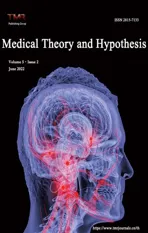Hypothesis of the osthol intervention in osteoarthritis treatment through COX-2 specific pathway
2022-06-28HaoChenXu
Hao-Chen Xu
1College of Traditional Chinese Medicine,Shandong University of Traditional Chinese Medicine,Jinan 250000,China.
Abstract Osteoarthritis(OA)is a joint degenerative disease characterized by softening and peeling of articular cartilage, reactive hyperplasia of subchondral bone, and narrowing of joint space, which seriously affects the quality of daily life of patients.Drug therapy is one of the effective means to treat osteoarthritis, it mainly includes the use of nonsteroidal antiinflammatory drugs, hormones and painkillers.These methods have a certain effect on alleviating symptoms, but there are also some obvious adverse reactions, and are not easy to take for a long time.Osthol is a natural coumarin isolated from Pinaceae plants.It has pharmacological effects such as anti-inflammatory, antioxidant and neuroprotective.A large number of studies and experiments show that Osthol has a good effect in the treatment of osteoarthritis, and no obvious harmful effect has been found.Therefore, by analyzing and sorting out the relevant experiments and literatures published in recent years, this paper puts forward some scientific hypotheses on the possible specific ways of regulating COX-2 mRNA expression, one of the important roles of Osthol in the treatment of osteoarthritis, in order to clarify the possible potential mechanism and inspire subsequent related research.
Keywords:osteoarthritis;Osthol;COX-2 pathway;hypothesis
Background
Osteoarthritis (OA) is a common joint degenerative disease characterized by softening and peeling of articular cartilage, reactive hyperplasia of subchondral bone and narrowing of joint space, causing pain, and even loss of function at the onset site,and seriously affecting the quality of daily life of patients [1–4].It not only brings pain to patients, but it has also caused a heavy burden on families and even society.Moreover, some changes in life caused by the development of modern science,technology,and the economy make OA not only improve the incidence of elderly groups but also affect young groups[5].Although the specific pathogenesis of osteoarthritis has not been clarified,studies have shown that COX-2 plays an important role in the pathogenesis of osteoarthritis[6].
Osthol (OST), also known as 7-methoxy-8-isopentenyl coumarin, is a derivative of coumarin obtained from OST plants, such as Danggui(Angelicae Sinensis Radix) and Shechuangzi (Cnidii Fructus).It has a wide range of pharmacological effects and various application levels, including but not limited to promoting glutamate release from nerve endings [7],inducing the bone formation of osteoblasts [8] and muscle relaxation [9].Besides, modern pharmacological studies have also found that OST has a variety of biological activities, especially anti-inflammatory and analgesic effects[10–11],which has a good effect on the treatment of osteoarthritis.In many mechanisms of OST, the regulation of COX-2 is a major mechanism for slowing down inflammation.Therefore, this paper mainly makes a pathway hypothesis on the mechanism of OST in the regulation of COX-2,in order to further provide a reference way for the specific mechanism of OST in the treatment of osteoarthritis.
Hypothesis
COX-2 is an isoenzyme of cyclooxygenase (COX), which is one of the important influencing factors of osteoarthritis.Relevant studies have shown that the expression level of [12–13] COX-2 mRNA generally tends to be higher in knee osteoarthritis patients, which will promote the production of COX-2.As a pGH synthase, COX-2 can regulate the content of PGF2 in synovial fluid, catabolize proteoglycan and type II collagen in cartilage matrix, inhibit anabolism, make it difficult to achieve a balance between synthesis and metabolism, and then cause the destruction of cartilage and bone.
Besides, based on the existing experimental analysis, OST can regulate PI3K/Akt pathway, matrix metalloproteinase and NF-κB [14–19], and three hypotheses are proposed.
The first pathway is OST by inhibiting IL-1β.The production of IL-1 affects IL-1β Mediated NF-κB signal transduction pathway indirectly inhibits the production and expression of COX-2 to treat osteoarthritis.
The second way, OST may affects COX-2 mRNA through ERK signaling pathway, and then regulates the expression of COX-2.ERK is an important member of the MAPK family,which can transmit signals from cell surface receptors to the nucleus.By searching the database, we can find that there is MAPK1 in the OST gene card.The existing literature also shows that OST can affect ERK signal pathway.After receiving noxious signal stimulation,resting ERK can be activated into Phospho-ERK,so as to start a series of downstream adaptive responses, transfer noxious signals into cells,and then affect the expression of relevant inflammatory molecules to regulate inflammation to a certain extent.Because the downstream target gene regulated by Phospho-ERK contains COX-2, and has the pathway of down-regulating COX-2 mRNA expression, it can inhibit the production of COX-2 and affect inflammation,thus affecting osteoarthritis.
The third pathway,OST takes PI3K/Akt signaling pathway as the target,regulates matrix metalloproteinases, down-regulates the expression of MMP-3, MMP-9 and MMP-13 proteins, and produces feedback regulation on COX-2 mRNA to inhibit the expression of COX-2 to influence osteoarthritis.
As for the specific biological functions of these pathways and proteins,most of them are theoretical binding targets of the OST.Furthermore, after binding to OST, these proteins and pathways directly or indirectly interact with other proteins to directly inhibit COX-2 or COX-2 mRNA expression.In addition, except for the above pathways, each pathway has the possibility of joint action.
Conclusion
There are three theoretically potential pathways of OST to influence the COX-2.In contrast,the detailed biological function of each protein and each pathway cannot be identified or proposed currently due to the insufficiency of relevant and literature.Moreover, these three pathways may occur simultaneously after the initiation from OST; not just one or some of the three pathways are activated.
The authors recommend first to validate whether OST can binding to targets of the aforementioned pathways and proteins, as to provide a reference for follow-up researchers.Based on the above theoretical point of view, Researchers can focus more on the detailed proteomic interaction pathway proposed in this article if the protein target is also identified.

Figure 1 The interaction network of the target proteins and pathways of the OST to influence COX-2.The arrows indicate the effects of positive and negative.
